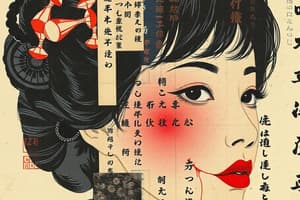Podcast
Questions and Answers
ひらがなの基本的な文字数はいくつですか?
ひらがなの基本的な文字数はいくつですか?
- 46 (correct)
- 40
- 50
- 60
以下の言葉で、外来語を表しているものはどれですか?
以下の言葉で、外来語を表しているものはどれですか?
- コーヒー (correct)
- おはようございます
- ありがとう
- さようなら
「お元気ですか?」の意味は何ですか?
「お元気ですか?」の意味は何ですか?
- お腹はすいていますか?
- あなたは元気ですか? (correct)
- 何時ですか?
- あなたの名前は何ですか?
「いいえ」の意味は何ですか?
「いいえ」の意味は何ですか?
「日本語で1」を表す漢字はどれですか?
「日本語で1」を表す漢字はどれですか?
水曜日は日本語で何と言いますか?
水曜日は日本語で何と言いますか?
日本語の基本的な文の構造はどれですか?
日本語の基本的な文の構造はどれですか?
「私はりんごを食べます」の主語はどれですか?
「私はりんごを食べます」の主語はどれですか?
「すみません」の意味は何ですか?
「すみません」の意味は何ですか?
What is the standard sentence structure in Japanese?
What is the standard sentence structure in Japanese?
Which particle indicates the object of a sentence in Japanese?
Which particle indicates the object of a sentence in Japanese?
What is the past affirmative form of a verb in Japanese?
What is the past affirmative form of a verb in Japanese?
Which script is used for native Japanese words?
Which script is used for native Japanese words?
What is the Japanese word for 'Tuesday'?
What is the Japanese word for 'Tuesday'?
Which of the following is the meaning of さようなら (sayounara)?
Which of the following is the meaning of さようなら (sayounara)?
What does the phrase 何ですか? (nan desu ka?) translate to in English?
What does the phrase 何ですか? (nan desu ka?) translate to in English?
Which of the following is a い (i) adjective?
Which of the following is a い (i) adjective?
Which of the following phrases means 'Excuse me' or 'I'm sorry'?
Which of the following phrases means 'Excuse me' or 'I'm sorry'?
What does the particle に (ni) indicate in a sentence?
What does the particle に (ni) indicate in a sentence?
Flashcards are hidden until you start studying
Study Notes
Hiragana and Katakana
-
Hiragana
- Syllabary used for native Japanese words and grammatical functions.
- 46 basic characters representing distinct sounds.
- Includes diacritics for voiced consonants (e.g., か → が).
-
Katakana
- Syllabary used for foreign words, onomatopoeia, and emphasis.
- 46 basic characters similar to Hiragana in sound.
- Used for loanwords like コーヒー (coffee) and テレビ (television).
-
Practice
- Familiarize with stroke order and pronunciation.
- Use flashcards or apps for memorization.
Common Phrases
-
Greetings
- こんにちは (Konnichiwa) – Hello/Good afternoon
- さようなら (Sayōnara) – Goodbye
- おはようございます (Ohayō gozaimasu) – Good morning
- こんばんは (Konbanwa) – Good evening
-
Polite Expressions
- ありがとう (Arigatou) – Thank you
- すみません (Sumimasen) – Excuse me/I'm sorry
- はい (Hai) – Yes
- いいえ (Iie) – No
-
Everyday Conversation
- お元気ですか? (Ogenki desu ka?) – How are you?
- はい、元気です (Hai, genki desu) – Yes, I am well.
Simple Vocabulary
-
Numbers
- 一 (いち, ichi) – 1
- 二 (に, ni) – 2
- 三 (さん, san) – 3
- 四 (し/よん, shi/yon) – 4
- 五 (ご, go) – 5
-
Days of the Week
- 月曜日 (げつようび, getsuyoubi) – Monday
- 火曜日 (かようび, kayoubi) – Tuesday
- 水曜日 (すいようび, suiyoubi) – Wednesday
- 木曜日 (もくようび, mokuyoubi) – Thursday
- 金曜日 (きんようび, kinyoubi) – Friday
-
Common Nouns
- いぬ (Inu) – Dog
- ねこ (Neko) – Cat
- たべもの (Tabemono) – Food
- みず (Mizu) – Water
Basic Grammar
-
Sentence Structure
- Basic order: Subject-Object-Verb (SOV)
- Example: 私はりんごを食べます (Watashi wa ringo o tabemasu) – I eat an apple.
-
Particles
- は (wa) – Topic marker
- を (o) – Object marker
- に (ni) – Indicates direction/time
- で (de) – Indicates location of action
-
Verbs
- Present tense: 食べます (tabemasu) – to eat
- Negative form: 食べません (tabemasen) – do not eat
-
Adjectives
- i-adjectives: たかい (takai) – high/expensive
- na-adjectives: きれい (kirei) – clean/beautiful (requires な before a noun)
-
Questions
- Structure: Add か (ka) at the end.
- Example: あなたは学生ですか? (Anata wa gakusei desu ka?) – Are you a student?
ひらがなとカタカナ
-
ひらがな
- 日本語の単語や文法機能に使われる音節文字。
- 46の基本文字があり、それぞれ異なる音を表す。
- 有声子音のための濁点を含む(例:か → が)。
-
カタカナ
- 外来語や擬音語、強調に使われる音節文字。
- ひらがなと同様に46の基本文字があり、音は同じ。
- コーヒーやテレビなどの貸語に使用される。
-
練習
- 書き順や発音に慣れることが重要。
- フラッシュカードやアプリを活用して覚える。
よく使うフレーズ
-
挨拶
- こんにちは – こんにちは/午後の挨拶。
- さようなら – お別れの挨拶。
- おはようございます – おはようの挨拶。
- こんばんは – こんばんはの挨拶。
-
丁寧な表現
- ありがとう – 感謝の表現。
- すみません – 失礼や謝罪の時に使用。
- はい – 肯定の返答。
- いいえ – 否定の返答。
-
日常会話
- お元気ですか? – あなたはお元気ですか?
- はい、元気です – はい、元気です。
基本語彙
-
数字
- 一 (いち) – 1
- 二 (に) – 2
- 三 (さん) – 3
- 四 (し/よん) – 4
- 五 (ご) – 5
-
曜日
- 月曜日 (げつようび) – 月曜日
- 火曜日 (かようび) – 火曜日
- 水曜日 (すいようび) – 水曜日
- 木曜日 (もくようび) – 木曜日
- 金曜日 (きんようび) – 金曜日
-
一般名詞
- いぬ – 犬
- ねこ – 猫
- たべもの – 食べ物
- みず – 水
基本文法
-
文の構造
- 基本的な語順は主語-目的語-動詞 (SOV)。
- 例:私はりんごを食べます – 私はリンゴを食べる。
-
助詞
- は (wa) – 主題マーカー。
- を (o) – 目的語マーカー。
- に (ni) – 方向や時間を示す。
- で (de) – 行動の場所を示す。
-
動詞
- 現在形:食べます – 食べる。
- 否定形:食べません – 食べない。
-
形容詞
- い形容詞:たかい – 高い/高価。
- な形容詞:きれい – 清潔/美しい(名詞の前に「な」を必要とする)。
-
質問
- 構造:文の最後に「か」を加える。
- 例:あなたは学生ですか? – あなたは学生ですか?
基本文法
- 文の構造: 日本語の標準構造は主語-目的語-動詞(SOV)
- 助詞:
- は (wa): トピックを示す
- が (ga): 主語を示す
- を (wo): 目的語を示す
- に (ni): 方向や時間を示す
- へ (e): 方向を示す
- で (de): 行動の場所を示す
- 動詞の活用:
- 現在肯定形: ます (masu) 形
- 現在否定形: ません (masen)
- 過去肯定形: ました (mashita)
- 過去否定形: ませんでした (masen deshita)
- 形容詞:
- い (i) 形容詞: 時制によって活用される
- な (na) 形容詞: 名詞の前に「な」(na) を必要とする
ひらがなとカタカナ
- ひらがな:
- 日本語の単語、文法機能、助詞に使用される
- 基本の46文字があり、それぞれが音を表す
- カタカナ:
- 外来語、借用語、擬音語に使用される
- ひらがなと同様に46文字からなる
- 練習: 両方の文字に慣れることが、読み書きに不可欠
基本語彙
- 数字:
- 一 (いち, ichi): 1
- 二 (に, ni): 2
- 三 (さん, san): 3
- 四 (し/よん, shi/yon): 4
- 五 (ご, go): 5
- 曜日:
- 月曜日 (げつようび, getsuyoubi): 月曜日
- 火曜日 (かようび, kayoubi): 火曜日
- 水曜日 (すいようび, suiyoubi): 水曜日
- 木曜日 (もくようび, mokuyoubi): 木曜日
- 金曜日 (きんようび, kinyoubi): 金曜日
- 土曜日 (どようび, doyoubi): 土曜日
- 日曜日 (にちようび, nichiyoubi): 日曜日
- 一般名詞:
- 学校 (がっこう, gakkou): 学校
- 友達 (ともだち, tomodachi): 友達
- 家 (いえ, ie): 家
- 食べ物 (たべもの, tabemono): 食べ物
一般的な表現
- 挨拶:
- こんにちは (konnichiwa): こんにちは/午後に
- おはようございます (ohayou gozaimasu): おはよう
- さようなら (sayounara): さようなら
- 丁寧な表現:
- ありがとうございます (arigatou gozaimasu): ありがとうございます
- すみません (sumimasen): すみません/ごめんなさい
- お願いします (onegaishimasu): お願いします
- 基本的な質問:
- 何ですか? (なんですか?, nan desu ka?): これは何ですか?
- どこですか? (doko desu ka?): どこですか?
- いつですか? (itsu desu ka?): いつですか?
Studying That Suits You
Use AI to generate personalized quizzes and flashcards to suit your learning preferences.



